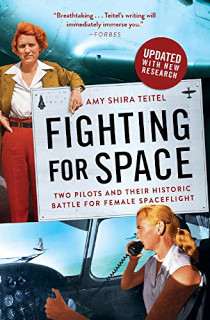
Author: Amy Shira Teitel
They say...
Spaceflight historian Amy Shira Teitel tells the riveting story of the female pilots who each dreamed of being the first American woman in space.
When the space age dawned in the late 1950s, Jackie Cochran held more propeller and jet flying records than any pilot of the twentieth century—man or woman. She had led the Women's Auxiliary Service Pilots during the Second World War, was the first woman to break the sound barrier, ran her own luxury cosmetics company, and counted multiple presidents among her personal friends. She was more qualified than any woman in the world to make the leap from atmosphere to orbit. Yet it was Jerrie Cobb, twenty-five years Jackie's junior and a record-holding pilot in her own right, who finagled her way into taking the same medical tests as the Mercury astronauts. The prospect of flying in space quickly became her obsession.
While the American and international media spun the shocking story of a "woman astronaut" program, Jackie and Jerrie struggled to gain control of the narrative, each hoping to turn the rumored program into their own ideal reality—an issue that ultimately went all the way to Congress.
This dual biography of audacious trailblazers Jackie Cochran and Jerrie Cobb presents these fascinating and fearless women in all their glory and grit, using their stories as guides through the shifting social, political, and technical landscape of the time.
I say...
I've been watching Ms. Teitel's YouTube channel—The Vintage Space![]() focused on the history of space flight—since the first video was published. I've enjoyed and learned from them all. It took me a while to get around to reading her book and it was worth it.
focused on the history of space flight—since the first video was published. I've enjoyed and learned from them all. It took me a while to get around to reading her book and it was worth it.
Individually, each of these women, Jackie Cochran and Jerrie Cobb, represents a compelling story that has been under-represented in the history of flight. Ms. Teitel has done a fine job of providing insight into each and their interaction, as well as their differences, regarding space flight. She does a fine job of weaving together the historical facts from her extensive research with the likely feelings each woman had at the time. And, she does not shy away from the sharp differences these two pioneers of flight had with each other regarding finding a way to get the first American woman in space. For many readers, the extent of consideration, selection, and testing of potential woman space flight candidates that took place in the 1960's may be surprising. If you are unfamiliar, read the book for that reason alone.
An enjoyable read and creditable job bringing much needed attention to these two American pioneers, which is long overdue.

